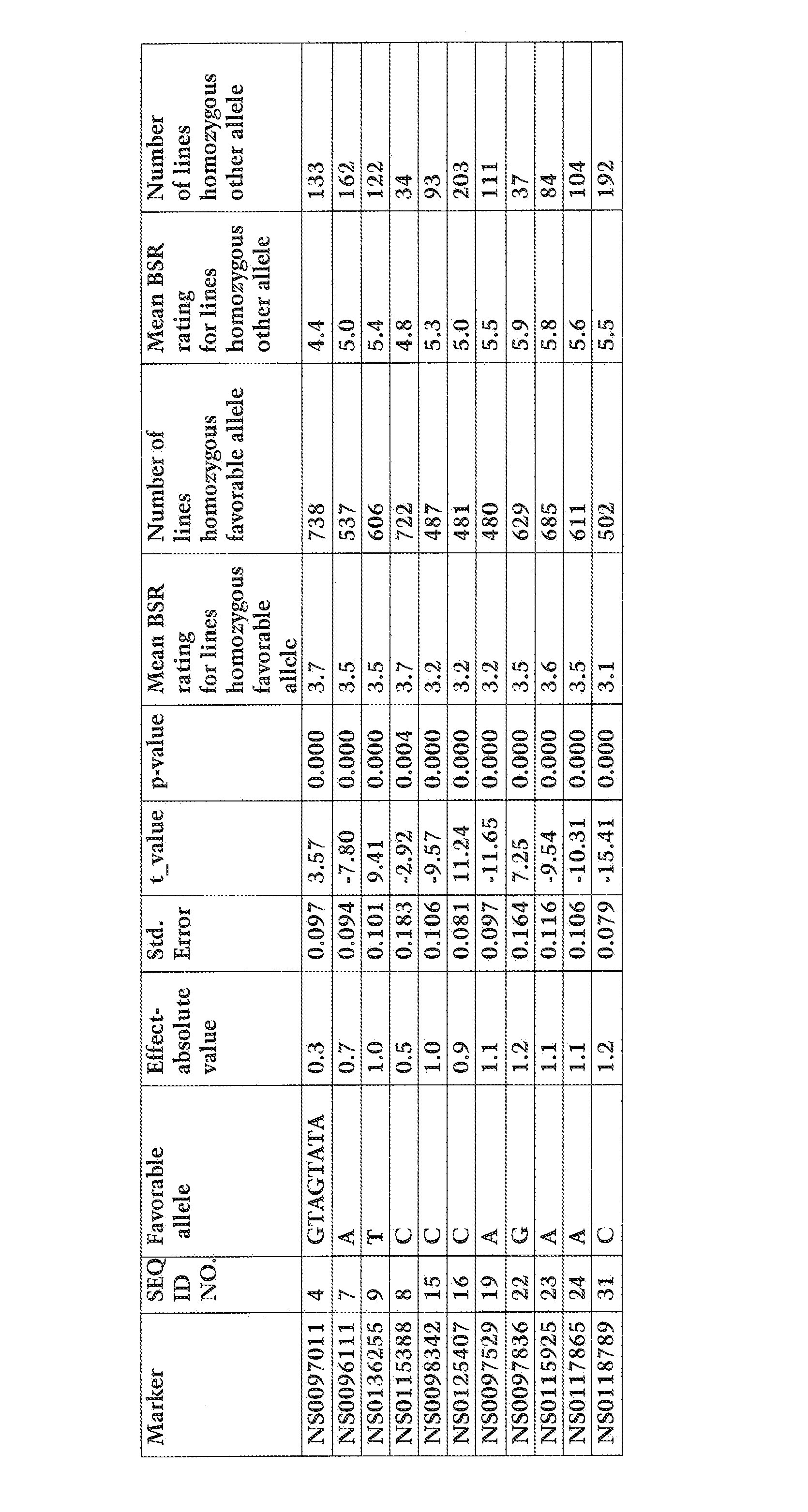Methods and compositions for selecting soybean plants resistant to brown stem rot
a technology of brown stem rot and soybeans, applied in the field of plant breeding and disease resistance, can solve the problems of inability to produce long-term survival structures, labor-intensive and time-consuming selection of bsr resistant plants based on phenotypic screening, and the abscission of susceptible leaves in susceptible plants is labor-intensive and time-consuming. , to achieve the effect of high oil production, high protein production and increased yield
- Summary
- Abstract
- Description
- Claims
- Application Information
AI Technical Summary
Benefits of technology
Problems solved by technology
Method used
Image
Examples
example 1
Determining Degrees of BSR Resistance
[0333]The phenotypic rating scale and definitions used herein to assess BSR resistance in soybean plants are included in Table 1. This rating scale provides the basis for disease ratings and determinations of resistance, immunity, or susceptibility herein. The main stems of plants exposed to Philophora gregata were split open and examined for browning and infection of pith and vascular tissue.
[0334]
TABLE 1Description of rating criteria used for BSR phenotyping.Phenotypic Results(% stem infected)RatingNo infection1 1-10%211-20321-35436-50551-65666-75776-858>859
example 2
Mapping with SATT244 and Application to SNP Markers
[0335]The SSR maker SATT244 maps to LG J and is known to associate with BSR resistance (Bachman et al., Crop Sci 41:527-535 (2001)). Because the SNP markers of the present invention co-locate with SATT244, this corroborates the utility of the markers of the present invention for screening and introgressing BSR resistance. A mapping population was developed from the cross of WILL / PI507354. WILL is the determinant isoline of the variety Williams. PI507354 is a source of BSR resistance. Sixty-nine individuals were screened with the SSR marker SATT244. The same meiotic event which was used for the mapping population in this study was also used to map soybean SNPs on the Monsanto SNP map. SATT244 maps within the same region as significant SNP markers for BSR resistance. The resistant source allele for SATT244 is from PI507354 and is denoted by the number 3 in Table 5. The susceptible allele for SATT244 is from WILL and is denoted by the ...
example 3
Mapping Population for BSR Resistance
[0337]The present invention includes SNP markers that are associated with BSR resistance. The markers were identified by evaluation of genotype and phenotype of progeny resulting from a cross between a BSR resistant parent and a BSR susceptible parent. A population was developed for interval mapping from the cross of a BSR resistance source AG3302 and a susceptible variety DKB25-51. From the DKB25-51 / AG3302 population, seven F1 seeds were planted. From these plants, 15 F2 seeds were harvested from 2 plants and 14 F2 seeds were harvested from the other five plants for a total of 100 F2 seeds. Replicates of DKB25-51 and AG3302 were also grown. Seed was submitted for BSR phenotyping and genotyping.
[0338]Thirteen SNP markers from LG J were used to screen the population. SNP markers NS0115388, NS0096111, NS0125407, NS0097529, NS0117865, and NS0118789 (SEQ ID NOs: 8, 7, 17, 19, 24, and 31) were found to be useful in predicting the BSR reaction.
[0339]Fo...
PUM
| Property | Measurement | Unit |
|---|---|---|
| temperature | aaaaa | aaaaa |
| melting temperature | aaaaa | aaaaa |
| melting temperature | aaaaa | aaaaa |
Abstract
Description
Claims
Application Information
 Login to View More
Login to View More - R&D
- Intellectual Property
- Life Sciences
- Materials
- Tech Scout
- Unparalleled Data Quality
- Higher Quality Content
- 60% Fewer Hallucinations
Browse by: Latest US Patents, China's latest patents, Technical Efficacy Thesaurus, Application Domain, Technology Topic, Popular Technical Reports.
© 2025 PatSnap. All rights reserved.Legal|Privacy policy|Modern Slavery Act Transparency Statement|Sitemap|About US| Contact US: help@patsnap.com

